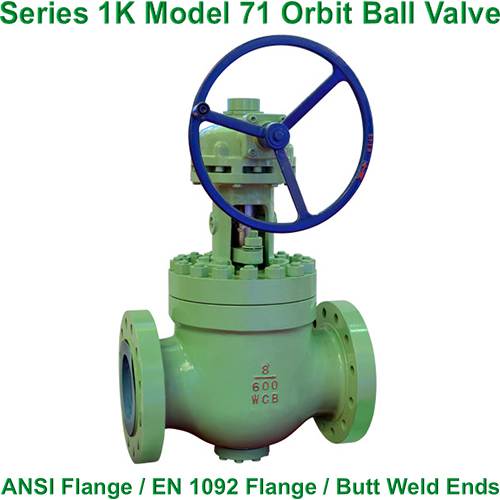Stock available today in 2″ – 12″, ANSI 150# – 900#
Carrying T3, T5 &T7 Trims with H & H8 seats options
ORBIT rising stem ball valve’s unique tilt-and-turn design reduces seal rubbing and delivers reliable performance. It is the proven technology for arduous process conditions, including high-temperature, critical isolation to molecular sieve switching services. This legacy of innovation began in 1912, when Alfred Heggem founded The Oilwell Improvements Company of Tulsa. Heggem’s groundbreaking ball valve seating principle, patented in 1935, was considered by many at the time to be the first major advancement for valves in half a century. This patent is the forerunner to all ball valves today.
Nearly 80 years later, the same engineering technology still is used to safeguard against seat rubbing—a leading factor for why ORBIT valves are world-renowned for high integrity and long service life.
ORBIT Low-E certified low emissions valve
Not all valves are created equal. Only ORBIT Low-E valves incorporate new sealing elements that have earned certification to ISO 15848 Tightness Class AH and API Standard 622 for both high- and low-temperature applications. By integrating advanced graphite-based technology with the proven ORBIT valve tilt-and-turn operation, ORBIT Low-E valves set a new benchmark for fugitive emissions (FE) performance at temperature extremes while increasing valve life even under dynamic cycling conditions.
ORBIT Valve Catalog
ORBIT Ball Valve Operation & Maintenance
History of ORBIT
ORBIT rising stem ball valve's unique tilt-and-turn design reduces seal rubbing and delivers reliable performance. It is the proven technology for arduous process conditions, including high-temperature, critical isolation to molecular sieve switching services. This legacy of innovation began in 1912, when Alfred Heggem founded The Oilwell Improvements Company of Tulsa. Heggem's groundbreaking ball valve seating principle, patented in 1935, was considered by many at the time to be the first major advancement for valves in half a century. This patent is the forerunner to all ball valves today.
Nearly 80 years later, the same engineering technology still is used to safeguard against seat rubbing—a leading factor for why ORBIT valves are world-renowned for high integrity and long service life.
Ideal for applications that require zero leakage and frequent operation, Cameron ORBIT rising stem ball valves are used globally in gas processing plants using molecular sieve systems in switching service.
Every ORBIT rising stem ball valve incorporates a proven tilt-and-turn operation that eliminates seal rubbing, which is the primary cause of valve failure. The absence of seal rubbing during both opening and closing means easy, low-torque valve operation and long-term reliable performance.
When an ORBIT rising stem ball valve is closed, the core is mechanically wedged tightly against the seat, ensuring positive shutoff. When a valve begins to open, the core tilts away from the seat and line flow passes uniformly around the core face. This eliminates the localized high-velocity flow that typically creates uneven seat wear in ordinary ball, gate, and plug valves. The core then rotates to the fully open position.
ORBIT Low-E certified low emissions valve
Not all valves are created equal. Only ORBIT Low-E valves incorporate new sealing elements that have earned certification to ISO 15848 Tightness Class AH and API Standard 622 for both high- and low-temperature applications. By integrating advanced graphite-based technology with the proven ORBIT valve tilt-and-turn operation, ORBIT Low-E valves set a new benchmark for fugitive emissions (FE) performance at temperature extremes while increasing valve life even under dynamic cycling conditions.
Actuation and instrumentation
Cameron provides tailored packages that include valves, actuators, and instrumentation. Our actuation and instrumentation services for ORBIT rising stem ball valves provide reliable, trouble-free on-off operation and are especially suitable for simple or extensive instrumentation.
ORBIT rising stem ball valves can be equipped with perfectly matched valve linear actuators, and many capabilities can be added to the basic double-acting actuator. Models are available with a spring-return option to open or close. Manual override mechanisms also are available.
A variety of instrumentation capabilities can be provided to meet a variety of your system’s needs. Many common systems are available as economical standard packages. Pneumatically or electrically activated systems also are available.
Cameron provides both the valve and actuator, enabling a single source to be responsible for the complete package:
operations and maintenance advice
repair parts and field service
warranty.
FE type testing results
ORBIT Low-E valves were submitted to ISO 15848-1 type testing and earned certification for their excellent, industry-leading performance results, achieving the best possible ISO 15848-1 tightness class rating of AH at the limits of the valve design temperature:
High-temperature packing: ISO FE AH—CO2—SSA 0—t (RT, 400 degC)—CL2500—ISO15848-1
Low-temperature packing: ISO FE AH—CO3—SSA 3—t (RT, –50 degC)—CL2500—ISO15848-1.
Stem packing enhancements
After extensively testing the performance of numerous stem packings, Cameron selected packings for the high-temperature and low-temperature applications that both achieved leak rates below 10 ppmv in independent validation tests.
Bonnet and stem guide gasket enhancements
Spring-energized metallic seals are employed for the ORBIT Low-E valve gaskets to leverage their unique combination of elasticity and plasticity. They are the industry’s best-performing seals, maintaining low FE (<50 ppmv)="" through="" thermal="">
Fire tested for high dependability
The packing and gaskets are proven dependable in fire testing per API Standard 607 Fire Test.
Features
No rub between sealing surfaces
Injectable packing
Single-seat design
Long life
Optimal flow: full port or reduced port openings give high CV figures
Top-entry design
Dual stem guides
Self-cleaning
Low-torque operation
Wear-resistant hard facing on core
Mechanical cam closure
Compliance
API 6D
ISO 9001:2008
PED 97/23/EC
ATEX Directive 94/9/EC
GOST
GOST-R certificate and RTN permit
ISO 15848-1 (fugitive-emission-type testing)
Shell GSI SPE 77/300 TAT qualified and TAMAP two-star rating
ASME B16.34


